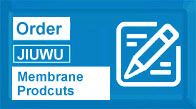Dyeing and printing wastewater has always been difficult to treat. It has the following characteristics: high color caused by a large amount of free dye residues in the water; the production process generally takes place at high temperatures, resulting in high wastewater temperatures; high COD concentrations that are difficult to degrade due to high molecular synthetic dyeing auxiliaries and dyes; high salt content in many dyeing auxiliaries leading to high wastewater conductivity; and high concentrations of AOX, sulfides, and heavy metals due to the chlorination bleaching process and some dyes containing halogens, sulfur, and heavy metals.
Microfiltration Membrane has pore sizes of 0.05~20.00μm, which generally can remove bacteria, solid particles, and other substances from water. Its separation mechanism is essentially the same as the traditional filtration screening mechanism, with the physical structure of the membrane being the defining factor for separation effectiveness. Microfiltration is mainly used for removing insolubles and suspended solids in dyeing waste paste and wash water, as well as for pretreatment for ultrafiltration, nanofiltration, and reverse osmosis.
Microfiltration membranes have highly uniform pore size distribution and high separation efficiency; they have high porosity, generally reaching over 70%. Additionally, the thickness of mostmicrofiltration membranes ranges between 90~105μm, which significantly speeds up filtration. Compared with other filtration processes, microfiltration membranes form a uniform continuum with no medium shedding during filtration, preventing secondary pollution.
The membrane separation mechanism is very complex, influenced by many factors. The driving forces for fluid through the membrane are mainly pressure difference, partial pressure difference, concentration difference, potential difference, and chemical potential difference. Selectivity and flux are important technical indicators for membrane separation.
Microfiltration Membrane contamination can be divided into two parts: the colloidal and macromolecular substances in the liquid interact with the membrane, depositing on the membrane surface to form a gel layer, also known as a filter cake layer; and solid suspensions like inorganic salts enter the membrane pores, causing clogging.
Cleaning methods are mainly physical and chemical. Physical methods include high-speed water washing, empty air cleaning, mechanical sponge ball scrubbing, backwashing, and more recently studied ultrasonic cleaning, all characterized by simplicity. Chemical cleaning usually involves chemical cleaners such as diluted alkalis, diluted acids, enzymes, surfactants, chelating agents, and oxidants.
Membrane separation technology, as a novel and efficient water treatment technology, has gained widespread attention as an economically and technically feasible method for treating printing and dyeing wastewater, with practical applications already in some cases. Themicrofiltration membrane separation method not only effectively treats printing and dyeing wastewater to achieve discharge standards but also recovers some dyes and dyeing auxiliaries, improving water and energy utilization efficiency. Hence, in treatment, it is important to separate clear and turbid streams, treat them distinctly, and reuse them in stages to fully exploit the advantages, aiming to find the optimal process parameters formicrofiltration membrane separation. This would industrialize membrane separation technology in printing and dyeing wastewater treatment. Membrane separation technology is a clean production process that can achieve resource separation and reuse, bringing significant environmental and economic benefits.




 +86-25-58849045
+86-25-58849045
 +86-25-58749295
+86-25-58749295
 jiuwu@jiuwu.com
jiuwu@jiuwu.com
 No. 9 Park Road, Pukou District, Nanjing City (Sanqiao Factory)
No. 9 Park Road, Pukou District, Nanjing City (Sanqiao Factory) Call us on:
Call us on:  Email Us:
Email Us:  No. 9 Park Road, Pukou District, Nanjing City (Sanqiao Factory)
No. 9 Park Road, Pukou District, Nanjing City (Sanqiao Factory)

 English
English 한국어
한국어 français
français русский
русский Español
Español
